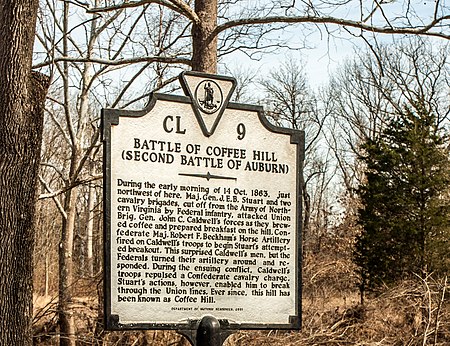Auburn Battlefield
Battlefields of the Eastern Theater of the American Civil WarBuildings and structures in Fauquier County, VirginiaConflict sites on the National Register of Historic Places in VirginiaFauquier County, Virginia Registered Historic Place stubsHistoric districts on the National Register of Historic Places in Virginia ... and 3 more
NRHP infobox with nocatNational Register of Historic Places in Fauquier County, VirginiaVirginia in the American Civil War

Auburn Battlefield, also known as Coffee Hill Battlefield, is a national historic district and American Civil War battlefield located near Catlett, Fauquier County, Virginia. It encompasses the areas of the two Auburn battles on October 13 and 14, 1863, and includes 18 contributing buildings, 23 contributing sites, and 8 contributing structures. The battles are referred to as the First Battle of Auburn and Second Battle of Auburn.It was listed on the National Register of Historic Places in 2011.
Excerpt from the Wikipedia article Auburn Battlefield (License: CC BY-SA 3.0, Authors, Images).Auburn Battlefield
Westwood Road,
Geographical coordinates (GPS) Address Nearby Places Show on map
Geographical coordinates (GPS)
| Latitude | Longitude |
|---|---|
| N 38.626388888889 ° | E -77.670555555556 ° |
Address
Westwood Road
Westwood Road
20138
Virginia, United States
Open on Google Maps





